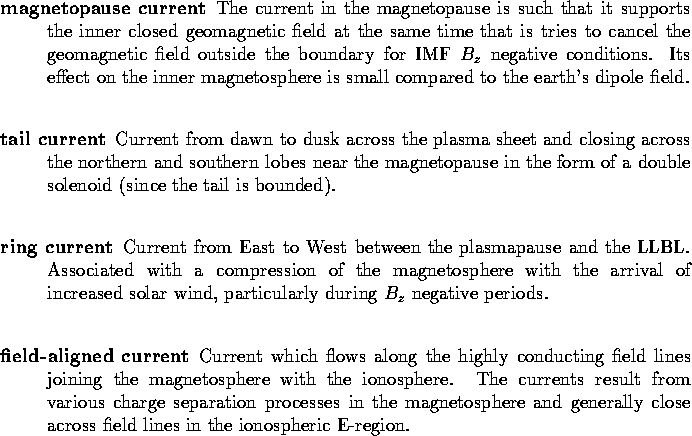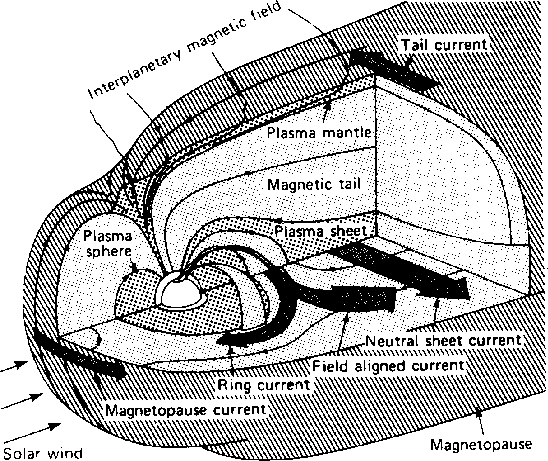The motion of the solar wind plasma across the magnetosphere generates a
potential difference across it. An estimate of the magnitude of this field
can be derived. For this calculation the geocentric solar ecliptic
(GSE) coordinate system with the origin in the center of the earth, the x-axis
toward the center of the sun ( ![]() ), the y-axis in the ecliptic
plane toward dusk (
), the y-axis in the ecliptic
plane toward dusk ( ![]() )
and the z-axis perpendicular to the ecliptic plane and northward, is used.
)
and the z-axis perpendicular to the ecliptic plane and northward, is used.
The solar wind moves radially outward to a first approximation:
![]()
The potential difference V developed as the solar wind flows across the earth's magnetosphere of width L (in dawn-dusk direction) is:
![]()
For typical values of ![]() ,
,
![]() and
and ![]() the
resulting
potential difference is of the order of
the
resulting
potential difference is of the order of ![]() . In practice, the actual
value is much less (30-60 kV) because the solar wind speed is reduced as it
crosses the bow shock and because the relative solar wind speed across the
open field lines in the polar region is reduced, since these lines are
attached to the earth at one end leading to a drag on the solar wind.
. In practice, the actual
value is much less (30-60 kV) because the solar wind speed is reduced as it
crosses the bow shock and because the relative solar wind speed across the
open field lines in the polar region is reduced, since these lines are
attached to the earth at one end leading to a drag on the solar wind.
The magnetosphere holds several distinct populations of charged particles (see Figure 2.2). Closest to the earth is the plasmasphere, a region that is closely linked to the high-latitude ionosphere and bounded by the plasmapause. In the Van Allen zone, highly energetic particles are trapped on closed field lines. They make a major contribution to the ionization of the upper atmosphere when they precipitate from the trapping region. The plasma sheet that is associated with the magnetotail and its inner edge is a source of particles for the ring current that flows in the magnetosphere during disturbed conditions. At the high-latitude interface between the magnetopause and the lobe is an open field line boundary layer called the plasma mantle. Similarly (not shown in Figure 2.2) there is a low latitude boundary layer (LLBL) between the magnetopause and the sunward-flowing plasma in the ring current region. Particles in the mantle originate from the solar wind and the polar wind, an upward flow of those ionospheric ions that are too energetic to be held by gravity.
The combination of plasma and electric field in the magnetosphere allows electric currents to flow. Table 2.1 summarizes important current systems and Figure 2.3 shows their configuration withing the magnetosphere.

Table 2.1: Magnetospheric current systems

Figure 2.3: Current systems in the magnetosphere (from T. A. Potemra)
Field-aligned currents (FACs) are the result of charge separation through
the interaction between the
earth's field lines and the particle populations in various magnetospheric
regions, particularly the LLBL, the ring current, the mantle and the polar
cap.
The currents are generated most strongly
when the IMF ![]() component is southward. They are weaker and occur at
higher latitude when the IMF
component is southward. They are weaker and occur at
higher latitude when the IMF ![]() is northward. The electric potential
generated in the outer magnetosphere maps down along the highly conducting
field lines to the ionosphere in the
auroral zone and the polar cap. The resulting ionospheric electric field
drives the F-region plasma at the Hall drift velocity given by
is northward. The electric potential
generated in the outer magnetosphere maps down along the highly conducting
field lines to the ionosphere in the
auroral zone and the polar cap. The resulting ionospheric electric field
drives the F-region plasma at the Hall drift velocity given by
![]()
producing the typical plasma convection patterns that are observed with the SuperDARN radar.